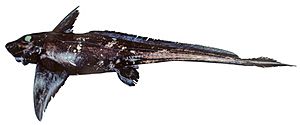Black ghostshark facts for kids
Quick facts for kids Black ghostshark |
|
|---|---|
 |
|
| Hydrolagus homonycteris | |
| Conservation status | |
| Scientific classification | |
| Genus: |
Hydrolagus
|
| Species: |
homonycteris
|
The black ghostshark (Hydrolagus homonycteris) is a fascinating deep-sea fish. It's also known as the black chimaera. This unique creature lives deep in the ocean near Australia and New Zealand. You can find it in the southwestern Pacific Ocean. It usually lives between 500 and 1,450 meters (about 1,640 to 4,757 feet) deep. Black ghostsharks have dark bodies, either black or dark brown. Males can grow up to 108 centimeters (about 42.5 inches) long. Even though they are sometimes caught by accident, they are not in danger. The IUCN lists them as "least concern."
Contents
What's in a Name? The Black Ghostshark's Story
The black ghostshark was first described by a scientist named Dominique A. Didier in 2008. It belongs to a group of fish called Hydrolagus. There are 23 different species in this group.
Why is it Called Hydrolagus?
The name Hydrolagus comes from two old Greek words. Hydro means "water," and lagos means "hare." So, its genus name means "water hare."
The Meaning of Homonycteris
The second part of its name, homonycteris, is a bit more fun! It combines the Latin word homo, meaning "man," and nycteris, meaning "bat." This name was chosen to honor a professor named Thomas A. Griffiths. His students at Illinois Wesleyan University used to call him "bat man."
What Does a Black Ghostshark Look Like?
The black ghostshark has a very distinct appearance. Its body can grow up to 66 centimeters (about 26 inches) long. Males can reach a total length of 108 centimeters (about 42.5 inches).
Color and Features
This fish is usually dark in color. It can be black or a very dark shade of brown. It has large eyes that help it see in the deep, dark ocean. Its snout is slightly pointed. The black ghostshark also has a large spine on its back. Its pelvic fins, located near its belly, are round.
How It Compares to Other Ghostsharks
The black ghostshark looks a lot like its close relative, the abyssal ghostshark. However, there are a few differences. The black ghostshark has a longer back spine. Its claspers, which are special organs on males, are darker and smaller than those of the abyssal ghostshark.
Where Do Black Ghostsharks Live?
Black ghostsharks live in the southwestern Pacific Ocean. You can find them off the coasts of Australia and New Zealand.
Australian Waters
In Australia, they live in the southeastern part of the country. This includes areas from Portland, Victoria, all the way to Ulladulla, New South Wales. They are found in the states of New South Wales, Tasmania, and Victoria. In Australian waters, they prefer depths between 870 and 1,450 meters (about 2,854 to 4,757 feet).
New Zealand Waters
In New Zealand, black ghostsharks are found from the West Norfolk Ridge to the Campbell Plateau. They live in slightly shallower waters here. Their depth range is usually between 500 and 1,400 meters (about 1,640 to 4,593 feet). These fish are often found on the continental slope and around underwater mountains called seamounts.
Are Black Ghostsharks in Danger?
The good news is that the black ghostshark is not considered to be in danger. It is listed as "least concern" by the IUCN. This means its population is stable.
Fishing and Bycatch
Sometimes, black ghostsharks are caught by accident. This is called "bycatch." In New Zealand, a study showed that more of these fish were caught between 1990 and 2010. They are usually caught by fishing boats that use large nets called trawls in deep waters. While they are sometimes caught on purpose in New Zealand, it's not clear what they are used for there. In June 2018, New Zealand's Department of Conservation officially listed the black ghostshark as "Not Threatened."
Safety in Australia
In Australia, black ghostsharks are also caught as bycatch, but not very often. A fishing area called the South Tasman Rise Fishery used to be a threat. However, it closed in 2007, which made the black ghostshark safer in Australian waters. This fish is safe to eat and has good quality meat. Because there are no major threats to the black ghostshark right now, no special conservation efforts are needed for it.


